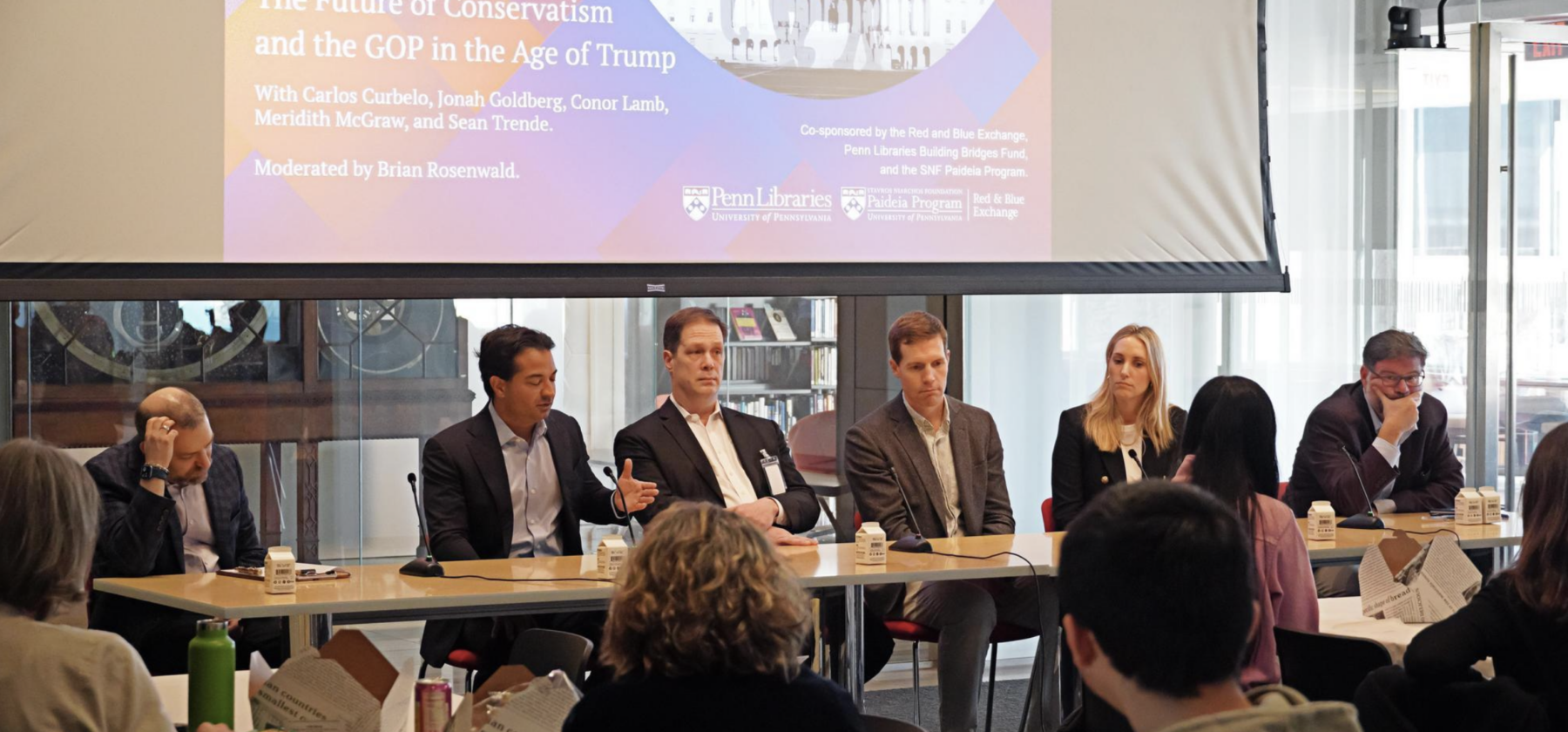At a recent Penn forum, a panel of political pundits, analysts and former elected officials from both parties addressed the history and future of the GOP and the conservative movement. The Republican Party of the future, they said, is a new breed of conservative movement powered by populism with roots going back to the 1960s, thanks in part to the realignment of traditional party coalitions.
“The Future of Conservatism and the GOP in the Age of Trump” was co-sponsored by the Red and Blue Exchange, Penn Libraries Building Bridges Fund, and SNF Paideia Program, with a common interest in promoting respectful dialogue across social, cultural, and political differences. It was moderated by Brian Rosenwald, Red and Blue Exchange director and Senior Affiliate at Penn’s Partnership for Innovation, Cross-Sector Collaboration, Leadership, and Organization.
The panel featured Carlos Curbelo, a former Republican congressman from Florida and an analyst for NBC News; Sean Trende, senior elections analyst for RealClearPolitics; Conor Lamb, a former Democratic congressman from western Pennsylvania; Meridith McGraw, White House reporter for The Wall Street Journaland formerly with Politico; and Jonah Goldberg, syndicated columnist and founder of The Dispatch.
The conservative movement has always had some more right-wing views that today are expressed by the current administration, Trende said. But during the Cold War, the presence of an international opponent unified the factions, a state of affairs that ended in 1992.
“The Soviet Union held it together,” Trende said. “If you were a religious conservative, it was the fight against godless atheism. If you were an internationalist on foreign policy, you liked fighting against the evil empire. If you were a realist on foreign policy, you liked containing the Soviet Union. If you were economically conservative, the contrast with communism was plain enough.”
McGraw said two things have occurred in recent years: a gradual evolution of the Republican Party and a realignment of traditional coalitions, noting the presence of former Democrats in Donald Trump’s cabinet and a union president speaking at the Republican National Convention. “This realignment is spurred by, I think, the cultural phenomena that we’re seeing but also demographic changes across the country,” she said.
Lamb said he has seen that shift in his former district in western Pennsylvania: an incremental adjustment over the decades. “Same people, same families, same unions. They just gradually changed their mind and left my party and went over to the Republicans,” he said. “If you were able to translate it into their terms, they would say [Trump’s] not conservative, and that’s what they like about him. They’re against the way things are now, and they wanted him to smash it up and break it down.”
In Curbelo’s view, the age of Trump is characterized by culture rather than economic issues. “Trump managed to make it culture,” Curbelo said. “What he has built his political business on is this idea of conserving traditional American culture, which a lot of people feel has been under assault for a long time.”
Goldberg said that part of the change in the conservative movement can be attributed to “populist rage” with origins in the financial crisis of 2007-08. He said that, while the Democratic Party has traditionally been the party of populism, the former GOP had been “playing with matches” for years and wasn’t able to cope with the rise of Trump. “The party is owned and operated by the populist wing,” he noted. “Donald Trump has moved the Republican Party to the left in ways that no other Republican could have.”
McGraw said the dynamic is also due in part to a distrust of the media and institutions. That view, she said, “has been growing, both the left and the right, for a long time. We are just seeing how siloed people have become and how people can pick and choose—cherry-pick—the information that they want.”
Looking ahead, Curbelo said, neither the Republicans nor Democrats are guaranteed a permanent majority. While the 2026 midterms should be better for the Democrats because of their more reliable voter base, the party also needs to become “closer to the cultural center of our country,” he said. If not, “it will be possible for Republicans to continue growing this multi-racial coalition.”

